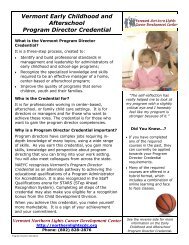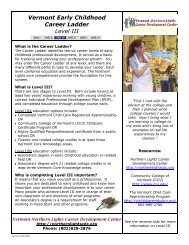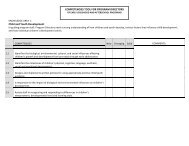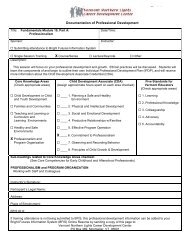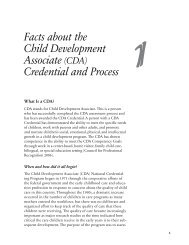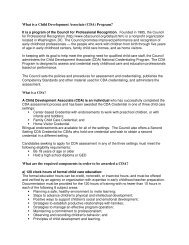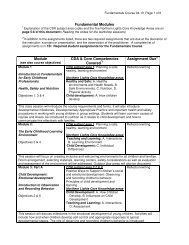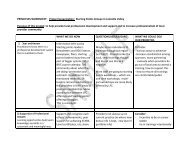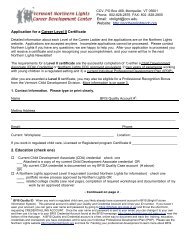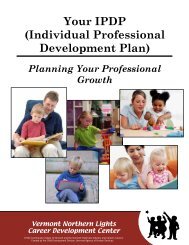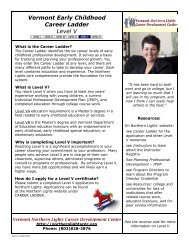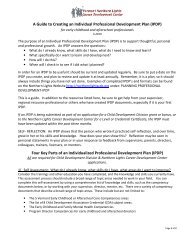Page 1 of 3 MODULE: Principles of Child Development - Vermont ...
Page 1 of 3 MODULE: Principles of Child Development - Vermont ...
Page 1 of 3 MODULE: Principles of Child Development - Vermont ...
You also want an ePaper? Increase the reach of your titles
YUMPU automatically turns print PDFs into web optimized ePapers that Google loves.
<strong>Page</strong> 1 <strong>of</strong> 3<br />
<strong>MODULE</strong>: <strong>Principles</strong> <strong>of</strong> <strong>Child</strong> <strong>Development</strong> and Learning LENGTH: 12 hours<br />
DESCRIPTION: This module focuses on the relationship between child development and the learning<br />
environment. Creating an inclusive environment is also addressed.<br />
NOTE: this module requires the participants to be observed outside <strong>of</strong> class, while working with children.<br />
See ASSIGNMENTS below.<br />
OBJECTIVES: This module is designed so that participants will acquire the knowledge and skills needed to:<br />
• use child development theory and research to identify the essential components <strong>of</strong> inclusive early<br />
childhood (birth- 5 years) learning environments<br />
• create inclusive learning environments that are responsive to the needs, strengths and interests <strong>of</strong><br />
children<br />
• understand and recognize the typical and atypical development <strong>of</strong> young children<br />
• use space, interactions, schedules and materials to construct an environment that encourages play,<br />
exploration and learning<br />
• describe how children acquire knowledge through play, interactions and documentation<br />
• use observation and documentation to create and adapt the learning environment<br />
• use the <strong>Vermont</strong> Early Learning Standards (VELS) as a guide for curriculum and program planning<br />
• identify community resources that <strong>of</strong>fer support to children with developmental and or health<br />
challenges<br />
LEVEL 2 Early <strong>Child</strong>hood CORE COMPETENCIES: Core Knowledge Areas and subheadings<br />
<strong>Child</strong> <strong>Development</strong>: How <strong>Child</strong>ren Develop, Influences on <strong>Child</strong> <strong>Development</strong>, Individual Variance<br />
Teaching and Learning: Interactions, Learning Environment, Curriculum and Content, Assessment<br />
CDA SUBJECT AREA(S)<br />
2. Physical and Intellectual <strong>Development</strong><br />
8. <strong>Principles</strong> <strong>of</strong> <strong>Child</strong> <strong>Development</strong> and Learning<br />
OUTLINE:<br />
Beginning Activities<br />
• Discovering Individual Patterns <strong>of</strong> Growth: Ask participants to line up in a continuum (youngest to<br />
oldest) in response to questions such as, age at <strong>of</strong> obtaining a drivers license, age first lived on your<br />
own, age you got your first paying job, etc. Notice these differences and relate them to children’s<br />
unique patterns and timing <strong>of</strong> growth/development.<br />
• What is included in the learning environment? Group brainstorm (generate: physical space,<br />
furnishings, routine, transitions, structure <strong>of</strong> the day/schedule, relationships, materials, curriculum,<br />
accessibility/adaptations…) Discover together what children learn from each <strong>of</strong> these aspects <strong>of</strong> the<br />
environment.<br />
• Why and How to Observe: Brainstorm the purpose <strong>of</strong> observation and strategies for observation.<br />
Topics<br />
• <strong>Child</strong> <strong>Development</strong> Theories (see Resources below and Northern Lights website -Level II grid )<br />
• Relationship between child behaviors and the learning environment<br />
• Inclusive environments & identifying and supporting children with special needs (may use developed<br />
curriculum posted on Northern Lights website- Level II grid)
<strong>Page</strong> 2 <strong>of</strong> 3<br />
• VELS overview<br />
• Open Ended Materials and VELS. This portion <strong>of</strong> the module can be met using one or more <strong>of</strong> the<br />
following options (see Level II grid)<br />
o Northern Lights Opened Ended Materials Curriculum<br />
o Working with Clay<br />
o Planning creative art experiences (focus on process)<br />
o Creative movement/Yoga<br />
o Sensory table<br />
o Beautiful Stuff - see Resources below<br />
ASSIGNMENTS: Assignments will encourage reflection and help learners connect knowledge to practice.<br />
Assignments have been aligned to specifically support pr<strong>of</strong>essionals preparing a CDA Credential portfolio<br />
(as noted below) as for the Level II portfolio review process. However, the assignments will benefit all<br />
class participants in their work with young children.<br />
Observation <strong>of</strong> the Practitioner A requirement <strong>of</strong> this Module is that the student is observed working<br />
with children, outside <strong>of</strong> class. Use this form Observation <strong>of</strong> the Practitioner II to guide the observation.<br />
In addition, here is Guidance for the course Instructor, Sponsor and Observer about this module<br />
component.<br />
Resources for children with special needs Collect contact information for local 2 agencies that provide<br />
these services. (CDA)<br />
Collect open-ended materials and bring them to class<br />
Design and implement an activity with children using open-ended materials. Observe and then<br />
document how the children interact with the materials and each other. Reflection- what did you notice?<br />
What did you learn about the children? How was it successful? What were the challenges? How might<br />
you change or extend the experience? (this can be started in class by observing a video and/or doing a<br />
role play with half the class ”playing” and half the class observing and documenting)<br />
Adapting the environment (can be done in class as small group discussion or as a written assignment)<br />
Using the activity/exploration completed by the class participants, set up a scenario that introduces a<br />
child with a developmental challenge. Ask the class participant to think about how they would need to<br />
adapt the experience for that child.<br />
RESOURCES: (Books, Articles, Websites, Guest Speakers)<br />
ARTICLES<br />
• Thinking Guide to Inclusive <strong>Child</strong> Care see Level II website grid<br />
BOOKS<br />
• Places for <strong>Child</strong>hoods; Making Quality Happen in the Real World- Jim Greenman<br />
• Living Designs- Curtis and Carter<br />
• Devereux Early <strong>Child</strong>hood Assessment (Environmental Checklist posted on website in VELS social<br />
emotional section).
<strong>Page</strong> 3 <strong>of</strong> 3<br />
• Beautiful Stuff! Learning with found Materials - Topal and Gandini<br />
• <strong>Development</strong>ally Appropriate Practice - Bredekamp NAEYC<br />
• Guide to <strong>Vermont</strong> Early Learning Standards (VELS) (also on VT Department <strong>of</strong> Education website:<br />
http://education.vermont.gov/new/html/pgm_earlyed/pubs.html<br />
• Theories <strong>of</strong> <strong>Child</strong>hood-Carol G. Mooney<br />
WEBSITES<br />
• Barriers to Inclusive <strong>Child</strong> Care: Research Study Findings and Recommendations<br />
from West Ed http://www.wested.org/cs/cpei/print/docs/339<br />
• National Association for the Education <strong>of</strong> Young <strong>Child</strong>ren (NAEYC) www.naeyc.org<br />
• American Academy <strong>of</strong> Pediatrics (developmental stages and more)<br />
http://www.aap.org/healthtopics/stages.cfm<br />
• Speech and Language <strong>Development</strong>: http://www.nidcd.nih.gov/health/voice/speechandlanguage.asp<br />
• Mayo Clinic: child development http://www.mayoclinic.com/health/child-development/MY00136<br />
• Center for Social Emotional <strong>Development</strong> <strong>of</strong> Early Learning (CSEFEL)<br />
http://www.vanderbilt.edu/csefel/index.html<br />
• Zero to Three www.zerotothree.org



